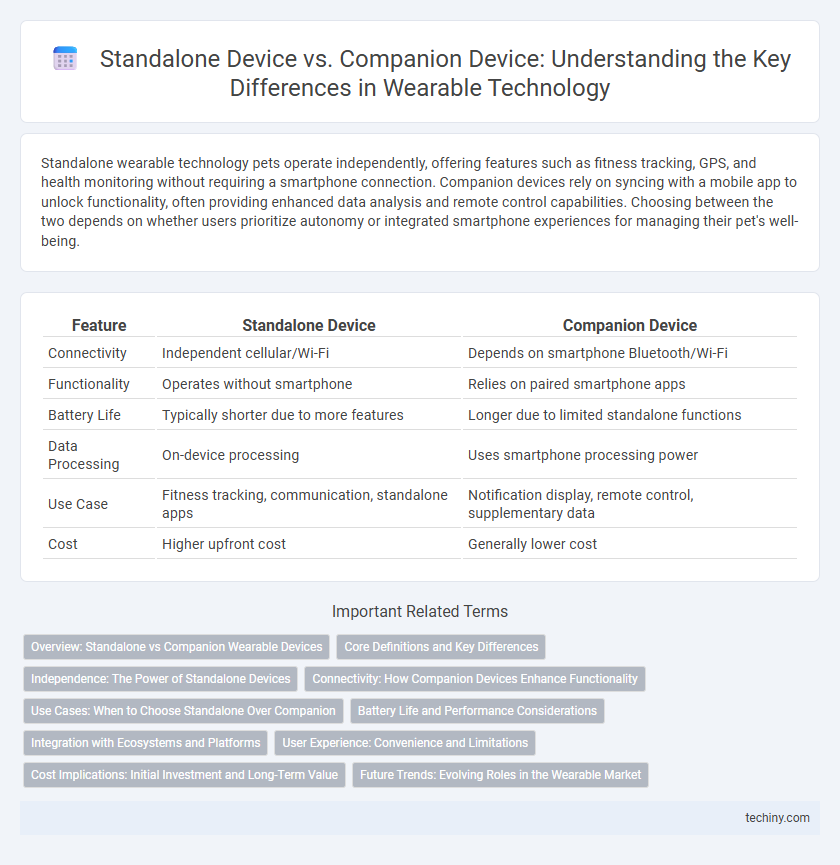Standalone wearable technology pets operate independently, offering features such as fitness tracking, GPS, and health monitoring without requiring a smartphone connection. Companion devices rely on syncing with a mobile app to unlock functionality, often providing enhanced data analysis and remote control capabilities. Choosing between the two depends on whether users prioritize autonomy or integrated smartphone experiences for managing their pet's well-being.
Table of Comparison
| Feature | Standalone Device | Companion Device |
|---|---|---|
| Connectivity | Independent cellular/Wi-Fi | Depends on smartphone Bluetooth/Wi-Fi |
| Functionality | Operates without smartphone | Relies on paired smartphone apps |
| Battery Life | Typically shorter due to more features | Longer due to limited standalone functions |
| Data Processing | On-device processing | Uses smartphone processing power |
| Use Case | Fitness tracking, communication, standalone apps | Notification display, remote control, supplementary data |
| Cost | Higher upfront cost | Generally lower cost |
Overview: Standalone vs Companion Wearable Devices
Standalone wearable devices operate independently with built-in cellular connectivity, GPS, and app support, enabling users to perform tasks without a paired smartphone. Companion wearable devices rely on smartphones for processing power and data connectivity, typically extending phone functionalities such as notifications, calls, and health tracking. The choice between standalone and companion wearables hinges on factors like user mobility, device autonomy requirements, and battery life preferences.
Core Definitions and Key Differences
Standalone wearable devices operate independently with built-in cellular or Wi-Fi connectivity, allowing direct access to apps and services without relying on other gadgets. Companion devices, however, require pairing with a smartphone or tablet to function, leveraging the host device's processing power and connectivity for features like notifications and app synchronization. Key differences include autonomy, battery life, and user interface complexity, with standalone devices offering greater freedom and companion devices relying on seamless integration for enhanced user experience.
Independence: The Power of Standalone Devices
Standalone devices offer complete independence by operating without the need for a paired smartphone or external device, providing seamless functionality such as GPS tracking, cellular connectivity, and app usage directly on the wearable. These devices empower users with real-time data access, enhanced mobility, and uninterrupted communication, making them ideal for active lifestyles and remote environments. The autonomy of standalone wearables ensures enhanced user convenience, reliability, and a fully integrated technology experience on the wrist.
Connectivity: How Companion Devices Enhance Functionality
Companion devices extend connectivity by linking wearable technology to smartphones or tablets via Bluetooth or Wi-Fi, enabling seamless data synchronization and real-time notifications. This enhanced connectivity allows wearables to access cloud services, stream media, and utilize GPS for precise tracking, which standalone devices may lack due to limited onboard resources. The reliance on companion devices for improved processing power and internet access significantly boosts overall functionality and user experience.
Use Cases: When to Choose Standalone Over Companion
Standalone wearable devices excel in fitness tracking, health monitoring, and real-time biometric analysis where independence from smartphones enhances user experience. Companion devices are preferred when seamless data synchronization with mobile apps, extended functionalities, and enhanced notifications are critical. Choosing standalone wearables is ideal for users prioritizing convenience, durability in outdoor activities, and scenarios with limited smartphone access.
Battery Life and Performance Considerations
Standalone wearable devices offer longer battery life and higher performance due to onboard processing power and independent connectivity, eliminating reliance on a paired smartphone. Companion devices depend on a connected smartphone for processing and data transfer, which can limit battery efficiency and reduce overall performance due to constant Bluetooth usage. Choosing between standalone and companion wearables requires balancing the need for autonomous functionality against battery consumption and processing capacity constraints.
Integration with Ecosystems and Platforms
Standalone wearable devices operate independently, offering full functionality without reliance on smartphones or external devices, ensuring seamless integration with cloud services and native apps. Companion devices depend on smartphones or tablets for processing power and connectivity, enhancing user experience through synchronized ecosystems like Apple Health or Google Fit. Ecosystem compatibility directly influences device capabilities, data synchronization, and user convenience in wearable technology.
User Experience: Convenience and Limitations
Standalone wearable devices offer enhanced user convenience by functioning independently without requiring a paired smartphone, providing seamless access to features such as GPS tracking, music playback, and phone calls. Companion devices rely on connectivity to a smartphone, which can limit usability if the phone is unavailable or connection is lost, potentially causing interruptions in notifications and app functionality. The choice between standalone and companion wearables directly impacts user experience through differences in mobility, battery life, and feature accessibility.
Cost Implications: Initial Investment and Long-Term Value
Standalone wearable devices typically require a higher initial investment due to built-in processing power, storage, and connectivity, eliminating the need for a paired smartphone. Companion devices often have lower upfront costs but rely on continuous synchronization with a primary device, which can incur additional expenses over time for data plans and maintenance. Evaluating long-term value involves considering durable battery life, software updates, and potential savings from reduced dependency on multiple gadgets.
Future Trends: Evolving Roles in the Wearable Market
Standalone devices are increasingly integrating advanced sensors, AI capabilities, and enhanced processing power, enabling independent functionality without relying on smartphones. Companion devices continue to evolve by providing seamless connectivity and specialized features that complement standalone wearables, such as health monitoring and contextual notifications. The wearable market is moving towards hybrid models that leverage the strengths of both, emphasizing user convenience, real-time data analysis, and ecosystem interoperability.
Standalone Device vs Companion Device Infographic

 techiny.com
techiny.com